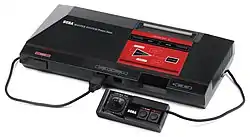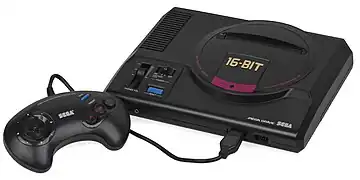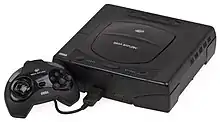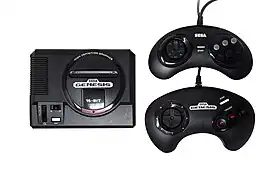
Sega is a video game developer, publisher, and hardware development company headquartered in Tokyo, Japan, with multiple offices around the world. The company has produced home video game consoles and handheld consoles since 1983; these systems were released from the third console generation to the sixth. Sega was formed from the merger of slot machine developer Service Games and arcade game manufacturer Rosen Enterprises in 1964, and it produced arcade games for the next two decades. After a downturn in the arcade game industry in the 1980s, the company transitioned to developing and publishing video games and consoles.[1] The first Sega console was the Japan-only SG-1000, released in 1983. Sega released several variations of this console in Japan, the third of which, the Sega Mark III, was rebranded as the Master System and released worldwide in 1985. They went on to produce the Genesis—known as the Mega Drive outside of North America—and its add-ons beginning in 1988, the Game Gear handheld console in 1990, the Sega Saturn in 1994, and the Dreamcast in 1998.
Sega was one of the primary competitors to Nintendo in the video game console industry. A few of Sega's early consoles outsold their competitors in specific markets, such as the Master System in Europe. Several of the company's later consoles were commercial failures, however, and the financial losses incurred from the Dreamcast console caused the company to restructure itself in 2001. As a result, Sega ceased to manufacture consoles and became a third-party video game developer.[2] The only consoles that Sega has produced since are the educational toy console Advanced Pico Beena in 2005 and dedicated consoles such as the Sega Genesis Mini in 2019 and Game Gear Micro in 2020. Third-party variants of Sega consoles have been produced by licensed manufacturers, even after production of the original consoles had ended. Many of these variants have been produced in Brazil, where versions of the Master System and Genesis are still sold and games for them are still developed.
Consoles
| Console | Release date(s) | Discontinuation date(s) | Generation | Notes | Picture |
|---|---|---|---|---|---|
| SG-1000 | Third |
|
 | ||
| Master System | Third |
|
 | ||
|
Fourth |
|
 | ||
| Game Gear | Fourth |
|
 | ||
| Fourth |
|
 | ||
| Sega Pico | Fourth |
|
 | ||
| 32X |
| Fifth |
|
 | |
| Sega Saturn |
| Fifth |
|
 | |
| Dreamcast |
| Sixth |
|
 | |
| Advanced Pico Beena | 2011 | Sixth |
|
||
| Before 2022[60] | Eighth |  | |||
| Game Gear Micro | Still in production | Eighth |
|
||
| Still in production | Ninth |
Third-party variants
Licensed and unlicensed variants of Sega consoles have been produced by third-party companies. In Brazil, Tectoy created and released the Master System 3 Compact, which may function wirelessly with an RF transmitter. An SKU of this console targeted at female gamers, the Master System Girl, was molded in bright pink plastic. A more recent version, released in 2006 in Brazil as the Master System 3 Collection, contains 120 built-in games.[65] Another Master System variant, built as a handheld game console, was released by Coleco in North America in 2006.[66]
The Genesis was the first Sega console to receive third-party versions. Its first variants were released before any Master System variants, even though the Genesis was released three years after the Master System. Working with Sega Enterprises, JVC released the Wondermega, a Mega Drive and Mega CD combination with high quality audio, in Japan on April 1, 1992. The system was later redesigned by JVC and released as the X'Eye in North America in September 1994.[67] A Pioneer LaserActive add-on pack, developed by Sega, allows the system to play Genesis and Sega CD games.[68] Aiwa released the CSD-GM1, a combination Genesis/Sega CD unit built into a boombox. Several companies added the Genesis to personal computers, mimicking the design of Sega's TeraDrive; these include the MSX models AX-330 and AX-990 distributed in Kuwait and Yemen, and the Amstrad Mega PC distributed in Europe and Australia.[4] After the Genesis was discontinued, Majesco Entertainment released the Genesis 3 in North America as a budget version of the console in 1998.[69] Majesco also released a budget version of the Sega Pico in North America in August 1999.[70]
In Brazil, where the Genesis never ceased production, Tectoy released a portable version of the Genesis with twenty built-in games on December 5, 2007.[71] Another Tectoy variant of the console called "Mega Drive Guitar Idol", released in 2009 in Brazil, includes two six-button joypads and a guitar controller with five fret buttons.[72] That year, AtGames began producing two new Genesis variants in North America and Europe: the Firecore, which can play Genesis cartridges as well as preloaded games; and a handheld console, the Sega Gopher, as well as a dedicated motion console, the Sega Zone, preloaded with 20 Genesis games.[73] Companies such as Radica Games have released compilations of Genesis games in "plug-and-play" packages resembling the system's controller.[74]
References
- ↑ Fahs, Travis (2009-04-21). "IGN Presents the History of SEGA". IGN. Ziff Davis. Archived from the original on 2013-09-10. Retrieved 2014-09-14.
- ↑ Ahmed, Shahed (2001-01-31). "Sega announces drastic restructuring". GameSpot. Archived from the original on 2010-09-01. Retrieved 2009-09-20.
- ↑ "SG-1000" (in Japanese). Sega. Archived from the original on 2014-07-16. Retrieved 2014-02-14.
- 1 2 3 4 5 6 McFerran, Damien. "Retroinspection: Master System". Retro Gamer. Imagine Publishing (44): 48–53. ISSN 1742-3155.
- ↑ Battelle, John (December 1993). "The Next Level: Sega's Plans for World Domination". Wired. Condé Nast. Archived from the original on 2012-05-02. Retrieved 2013-10-09.
- ↑ Kohler, Chris (2009-10-02). "Playing the SG-1000, Sega's First Game Machine". Wired. Condé Nast. Archived from the original on 2014-01-01. Retrieved 2009-10-05.
- ↑ "SC-3000" (in Japanese). Sega. Archived from the original on 2014-07-16. Retrieved 2013-02-15.
- ↑ "SC-3000H" (in Japanese). Sega. Archived from the original on 2014-02-22. Retrieved 2013-02-15.
- ↑ "Mark III" (in Japanese). Sega. Archived from the original on 2014-07-16. Retrieved 2014-03-31.
- 1 2 3 4 Beuscher, David. "Sega Master System – Overview". AllGame. All Media Network. Archived from the original on 2014-11-14. Retrieved 2014-03-31.
- ↑ Cowen, Danny (2011-09-14). "Sega Master System Launch Schedule Reveals Unreleased Hot Rod, Phantasy Star II". GameSetWatch. UBM. Archived from the original on 2014-09-15. Retrieved 2014-06-22.
- ↑ Sheff, David (1993). Game Over (1st ed.). Random House. p. 349. ISBN 0-679-40469-4.
- 1 2 3 "Retroinspection: Mega Drive". Retro Gamer. Imagine Publishing (27): 42–47. 2006. ISSN 1742-3155.
- ↑ Kent, Steven L. (2001). The Ultimate History of Video Games: The Story Behind the Craze that Touched our Lives and Changed the World. Prima Publishing. pp. 404–405. ISBN 0-7615-3643-4.
- ↑ "Sega tops holiday, yearly sales projections; Sega Saturn installed base reaches 1.6 million in U.S., 7 million worldwide". Business Wire. Berkshire Hathaway. 1997-01-13. Archived from the original on 2013-04-11. Retrieved 2013-10-13.
- ↑ "Sega farms out Genesis". Consumer Electronics. Warren Communications News. 1998-03-02. Archived from the original on 2015-07-26. Retrieved 2012-07-09.
- ↑ Sega Service Manual (Supplement): Genesis II/Mega Drive II. Sega. 1993.
- ↑ Marriott, Scott Alan. "Sega Genesis Nomad – Overview". AllGame. All Media Network. Archived from the original on 2014-11-14. Retrieved 2013-10-05.
- ↑ Redsell, Adam (2012-05-20). "SEGA: A Soothsayer of the Game Industry". IGN. Ziff Davis. Archived from the original on 2013-10-12. Retrieved 2013-10-05.
- ↑ "Cartridge Console With 15 Sega Megadrive Games". Blaze Europe. Archived from the original on 2014-08-04. Retrieved 2010-07-16.
- ↑ Kent, Steven L. (2001). The Ultimate History of Video Games: The Story Behind the Craze that Touched our Lives and Changed the World. Prima Publishing. p. 447. ISBN 0-7615-3643-4.
- ↑ Clements, Matthew T.; Ohashi, Hiroshi (October 2004). "Indirect Network Effects and the Product Cycle: Video Games in the U.S., 1994–2002" (PDF). NET Institute. pp. 12, 24. Archived (PDF) from the original on 2016-03-07. Retrieved 2011-09-21.
- ↑ Forster, Winnie (2005). The Encyclopedia of Game.Machines: Consoles, Handhelds, and Home Computers 1972-2005. Magdalena Gniatczynska. p. 139. ISBN 3-0001-5359-4.
- 1 2 "Retroinspection: Sega Game Gear". Retro Gamer. Imagine Publishing (41): 78–85. 2009. ISSN 1742-3155.
- 1 2 3 "Sega Game Gear". Retro Gamer. Live Publishing (17): 26–35. 2005. ISSN 1742-3155.
- 1 2 Beuscher, David. "Sega Game Gear – Overview". AllGame. All Media Network. Archived from the original on 2014-11-14. Retrieved 2013-07-08.
- ↑ "Mega-CD" (in Japanese). Sega. Archived from the original on 2014-07-16. Retrieved 2014-03-29.
- ↑ Kent, Steven L. (2001). "The War". The Ultimate History of Video Games: The Story Behind the Craze that Touched our Lives and Changed the World. Prima Publishing. ISBN 0-7615-3643-4.
- 1 2 Birch, Aaron (2005). "Next Level Gaming: Sega Mega-CD". Retro Gamer. Live Publishing (17): 36–42. ISSN 1742-3155.
- ↑ Beuscher, David. "Sega CD – Overview". AllGame. All Media Network. Archived from the original on 2014-11-14. Retrieved 2013-06-27.
- ↑ "Mega-CD 2" (in Japanese). Sega. Archived from the original on 2014-05-30. Retrieved 2014-03-29.
- ↑ Marriott, Scott Alan. "Sega Genesis CDX – Overview". AllGame. All Media Network. Archived from the original on 2014-11-14. Retrieved 2013-06-27.
- ↑ "Videospiel-Algebra". Man!ac Magazine (in German). Cybermedia Verlagsgesellschaft. May 1995.
- ↑ ファミ通エクスプレス "ピコ"といっても紅茶じゃないぞッ! セガが幼児向けコンピューターを発売. Famicom Tsūshin (in Japanese). Vol. 8, no. 24. ASCII Media Works. 1993-06-11. p. 11.
- 1 2 "Sega captures dollar share of videogame market -- again; diverse product strategy yields market growth; Sega charts path for 1996". Business Wire. Berkshire Hathaway. 1996-01-10. Archived from the original on 2014-05-02. Retrieved 2011-09-29.
- 1 2 "TOSEC: Sega Pico". Internet Archive. 2012-04-13. Archived from the original on 2014-01-23. Retrieved 2014-06-22.
- 1 2 3 4 "食育、安全などの"五育"を取り入れ、エデュテイメント事業を推進「遊びながら学ぶ」が進化する『Advanced PICO BeenaTM』(アドバンスピコ ビーナTM)8月発売" (PDF) (in Japanese). Sega. 2005-04-05. Archived from the original (PDF) on 2007-09-28. Retrieved 2014-06-03.
- ↑ "Edison, N.J.-Based Firm Signs Video Game Distribution Deal with Sega". Home News Tribune. Gannett Company. 1999-08-06. Archived from the original on 2014-06-29. Retrieved 2011-09-29.
- 1 2 Beuscher, David. "Sega Pico – Overview". AllGame. All Media Network. Archived from the original on 2014-11-14. Retrieved 2014-06-03.
- ↑ "Sega Toys Business Strategy". Sega. 2005. Archived from the original on 2005-12-16.
- ↑ "Super 32X". Sega. Archived from the original on 2014-07-16. Retrieved 2014-02-23.
- 1 2 Kent, Steven L. (2001). "The "Next" Generation (Part 1)". The Ultimate History of Video Games: The Story Behind the Craze that Touched our Lives and Changed the World. Prima Publishing. ISBN 0-7615-3643-4.
- ↑ McFerran, Damien. "Retroinspection: Sega 32X". Retro Gamer. Imagine Publishing (77): 44–49. ISSN 1742-3155.
- 1 2 3 4 Beuscher, David. "Sega Genesis 32X — Overview". AllGame. All Media Network. Archived from the original on 2014-11-14. Retrieved 2013-06-07.
- ↑ "Sega Saturn" (in Japanese). Sega. Archived from the original on 2014-07-16. Retrieved 2014-03-03.
- ↑ Cifaldi, Frank (2010-05-11). "This Day in History: Sega Announces Surprise Saturn Launch". 1UP.com. Ziff Davis. Archived from the original on 2011-08-05. Retrieved 2014-05-04.
- 1 2 McFerran, Damien. "Retroinspection: Sega Saturn". Retro Gamer. Imagine Publishing (34): 44–49. ISSN 1742-3155.
- ↑ Kent, Steven L. (2001). The Ultimate History of Video Games: The Story Behind the Craze that Touched our Lives and Changed the World. Prima Publishing. pp. 558–559. ISBN 0-7615-3643-4.
- ↑ Moriarty, Colin (2013-04-18). "Sega Pluto: The console that never was?". IGN. Ziff Davis. Archived from the original on 2014-03-20. Retrieved 2014-03-03.
- ↑ Lefton, Terry (1998). "Looking for a Sonic Boom". Brandweek. Nielsen Business Media. 39 (9): 26–29. ISSN 1064-4318.
- ↑ Hernandez, Patricia (2013-11-28). "Happy 15th Birthday, Dreamcast!". Kotaku. Gawker Media. Archived from the original on 2014-03-29. Retrieved 2014-06-13.
- 1 2 "Dreamcast beats Playstation record". BBC News. 1999-11-24. Archived from the original on 2013-10-16. Retrieved 2008-08-19.
- ↑ "Sega Scraps the Dreamcast". BBC News. 2001-02-24. Archived from the original on 2014-08-13. Retrieved 2008-08-22.
- ↑ "Sega Sports NFL 2K1 Outsells the Competition on Its Debut; First Ever Online Console Game NFL 2K1 Becomes Number One Football Game This Fall". Business Wire. Berkshire Hathaway. 2000-11-28. Archived from the original on 2014-02-21. Retrieved 2008-08-19.
- ↑ Wilde, Tyler (2009-09-08). "A tribute to the Dreamcast VMU". GamesRadar+. Future. Archived from the original on 2014-09-15. Retrieved 2014-06-13.
- ↑ "Sega warns of losses". BBC News. 2000-02-28. Archived from the original on 2013-11-11. Retrieved 2014-06-13.
- ↑ "『BeenaLite(ビーナライト)』7月17日新発売" (PDF) (in Japanese). Sega. 2008-06-18. Archived (PDF) from the original on 2014-08-16. Retrieved 2014-10-23.
- 1 2 Robson, Daniel (March 30, 2019). "SEGA Genesis Mini Release Date, Price and Initial Games Lineup Revealed". IGN. Retrieved March 31, 2019.
- ↑ Glagowski, Peter (July 29, 2019). "The Genesis/Mega Drive Mini has been delayed in Europe". Destructoid. Retrieved 27 September 2019.
- 1 2 Machkovech, Sam (July 29, 2022). "Sega Genesis Mini 2 will be in much shorter supply than original". Ars Technica. Retrieved October 31, 2023.
- 1 2 Kohler, Chris (March 29, 2019). "Sega Will Release The Genesis Mini On September 19". Kotaku. Retrieved March 31, 2019.
- 1 2 3 4 5 Byford, Sam (June 3, 2020). "Sega's Game Gear Micro is four $50 consoles with four games each". The Verge. Retrieved June 3, 2020.
- 1 2 Lane, Gavin (July 13, 2022). "SEGA Genesis Mini 2 Confirmed For North American Release This October". Nintendo Life. Retrieved July 14, 2022.
- 1 2 3 4 Macy, Seth G. (November 10, 2022). "Sega Genesis Mini 2 Review". IGN. Retrieved October 31, 2023.
- ↑ Szczepaniak, John (2006). "Company Profile: Tec Toy". Retro Gamer. Imagine Publishing (30): 50–53. ISSN 1742-3155.
- ↑ Ransom-Wiley, James (2006-10-26). "Sega-filled handheld". Joystiq. AOL. Archived from the original on 2014-04-07. Retrieved 2010-04-22.
- ↑ Marriott, Scott Alan. "JVC X'Eye – Overview". AllGame. All Media Network. Archived from the original on 2014-11-14. Retrieved 2013-07-02.
- ↑ Marriott, Scott Alan. "Pioneer LaserActive – Overview". AllGame. All Media Network. Archived from the original on 2014-11-14. Retrieved 2013-07-02.
- ↑ Sheffield, Brandon (2009-08-10). "A Casual Rebirth: The Remaking of Majesco". Gamasutra. UBM. Archived from the original on 2014-05-10. Retrieved 2013-10-09.
- ↑ "Edison, N.J.-Based Firm Signs Video Game Distribution Deal with Sega". Home News Tribune. Gannett Company. 1999-08-06. Archived from the original on 2014-06-29. Retrieved 2011-09-29.
- ↑ Melanson, Donald (2007-11-13). "Brazil's TecToy cranks out Mega Drive portable handheld". Engadget. AOL. Archived from the original on 2013-10-12. Retrieved 2007-01-23.
- ↑ "Mega Drive Guitar Idol – 87 jogos" (in Portuguese). Tectoy. Archived from the original on 2009-08-26. Retrieved 2010-07-16.
- ↑ "Innex Launches Products Containing Licensed Sega Genesis Titles In Time For Q4 Holiday Season". Innex. September 2009. Archived from the original on 2014-07-22. Retrieved 2011-04-25.
- ↑ Horowitz, Ken (2004-09-16). "Hands-On: Arcade Legends (Plug-'n-Play)". Sega-16. Archived from the original on 2014-07-02. Retrieved 2013-11-17.